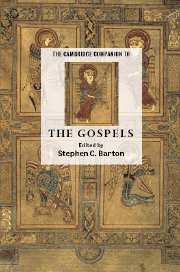Book contents
- Frontmatter
- Introduction
- Part I Approaching the gospels: context and method
- Part II The gospels as witnesses to Christ: content and interpretation
- 6 The Gospel according to Matthew
- 7 The Gospel according to Mark
- 8 The Gospel according to Luke
- 9 The Gospel according to John
- Part III The afterlife of the gospels: impact on church and society
7 - The Gospel according to Mark
from Part II - The gospels as witnesses to Christ: content and interpretation
Published online by Cambridge University Press: 28 January 2007
- Frontmatter
- Introduction
- Part I Approaching the gospels: context and method
- Part II The gospels as witnesses to Christ: content and interpretation
- 6 The Gospel according to Matthew
- 7 The Gospel according to Mark
- 8 The Gospel according to Luke
- 9 The Gospel according to John
- Part III The afterlife of the gospels: impact on church and society
Summary
More than one hundred years ago, Martin Kähler spoke of the gospels as 'passion narratives with extended introductions'. Although directed at all four of our New Testament gospels, subsequent research took this as a description especially of the Gospel of Mark. This label is now dismissed as overly simplistic, and rightly so, given the importance of Mk 1-10, chapters too easily marginalized when relegated to the status of mere introduction. Nevertheless, Kähler's formulation helpfully underscores the centrality of the cross of Christ to the Gospel of Mark at the same time as drawing attention to the fact that Mark's narration from Jesus' entry into Jerusalem to the empty tomb occupies fully one-third of the gospel. Indeed, there is no coming to terms with this gospel - its spirituality, christology, theology, ethical vision and so on - without giving maximal consideration to Jesus' ignominious demise at the hands of Roman justice. Perhaps more importantly, we have in Kähler's statement a reminder that the cross of Christ is cast within a larger plot, from which it draws its profound significance. How it does so is perhaps the central question confronting those who read and study Mark's narrative.
This is not only because the crucifixion of Jesus iswoven so pervasively – sometimes with subtlety, often explicitly – into the fabric of the narrative. It is also to recognize that the cross is capable of multiple interpretations, and that Mark’s gospel presses its readers in a particular direction as they seek both to make sense of Mark’s perspective on Jesus of Nazareth and to embody his vision of discipleship.
- Type
- Chapter
- Information
- The Cambridge Companion to the Gospels , pp. 139 - 157Publisher: Cambridge University PressPrint publication year: 2006
- 1
- Cited by

